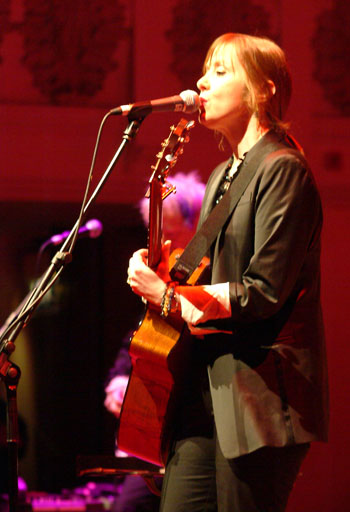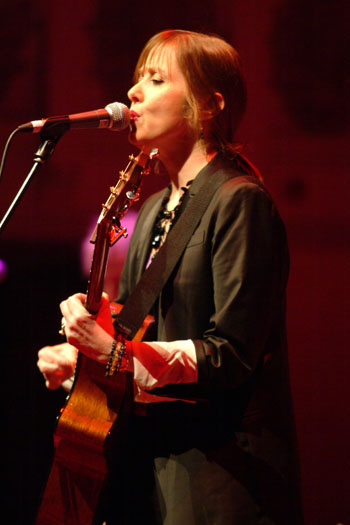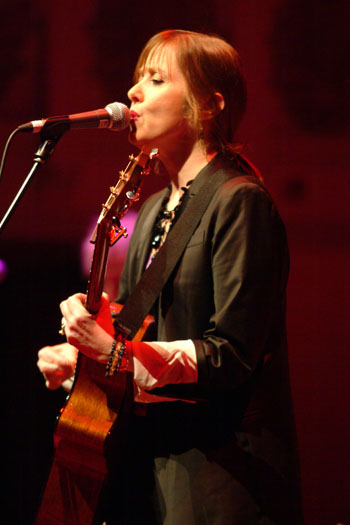With little over 10 minutes to enquire about a 25 year career,
Pete Feenstra kept the questions coming thick and fast to
contemporary folk artist and wordsmith Suzanne Vega. Promoting a
brand new re recorded collection of love songs 'Close-Up Vol 1'
the focus was mainly on her career retrospective.
You are celebrating your independence as a recording artist by
re–recording your back catalogue and splitting it into 4
Volumes?
Yes we're currently touring behind the 'Love Songs' collection
and then we're going to follow that with Volume two called
'People and Places', then 'States of Being' and finally 'Songs
of Family'.
The first one is a stripped down affair with songs I consider to
be love songs. The second volume will be a musically broader
collection with strings, percussion etc and Volume 3 – 'States
of Being' - is what I call the weird songs. That one will
feature more diverse sounds and will probably have more
distortion etc. Then the last one will be a basic folk album.
You started last night's Cadogen Hall show in London with
'Marlene on the Wall'. Was that because you wanted to get it out
the way as quickly as soon as possible? Is it an albatross much
like Don McClean's American Pie, in that you always have to play
it?
No not at all. I'm still very fond of it. But the reason we
start the evening with that song is that it's quite upbeat
compared to a lot of my songs (laughs).
It's also in a major key and is a good starting point to the
evening. We love playing it, sometimes we alter the arrangement
a little to keep it fresh and interesting.

And again going back to last night's show, you made it clear
that you consider it to be a love song?
Yes, I've had some discussions recently with journalists who
tell me it's about angst etc, but the subject is right there in
the first line and the song fits in with in with the different
ways I view love in the new collection.
You once said 'Songs brand us as part of a tribe. We can pick
and choose what tribe we belong'. What tribe would you describe
yourself as belonging to?
I'm not sure really, I wouldn't say I fit into any category
easily and not one identifiable tribe. I'd have to think back to
why I said that but I guess I'm more of a mixture really and I
draw from different elements and have done so through most of my
work.
So are you a singer song-writer first and poet second?
Well I guess professionally I'm the former but I started as a
poet and I still consider myself that way outside of what I do.
I still write poetry but the songs are the way I express my
thoughts.
Before you started this 4 volume thematic retrospective you
have also said you'd like to present a collection of songs in a
different way, so people could experience them in different
ways. Is that really possible with love songs that deal with
meaningful relationships, feelings etc?
Again I'm not sure if I remember what I meant by that at the
time. But in terms of taking the music on the road when I'm
touring songs do get presented in different ways, if only
because sometimes I have a band, and other times I play in a duo
or trio format.
On the other hand some of the songs stay fast to what they have
become down the years. But we do try and play around with some
songs in terms of keys and chords etc and try and keep them
interesting for both us and the audience. I always try to think
of the best way to present songs and a collection seems a good
way of doing that.

How did you decide which ones to include and which to leave
out?
I chose the songs I liked and thought about the ones that maybe
the audience would like to hear again. Then I thought about how
they might sound sonically in the various formats I was going to
present them.
For example, some songs don't necessarily lend themselves to a
simple acoustic arrangement. I was also thinking in terms of how
I'd play them live.
Does 'The Queen And The Soldier' fall into that category? It
could possibly have been included in the love songs album?
Yes I did think about that one in those terms, but 'The Queen
and The Soldier' will appear in Volume 2 under 'People and
Places'.
Do your songs come from first hand experiences?
A lot of them are yes but not always. They are about feelings as
well. But 'Song in Red and Grey' and 'Bound' are very much from
personal experience.
Two questions in one. Is the purpose of the new CD to reach
newer fans, or do you wish to drag old fans to their minimal
arrangements? And in going back to your older songs does that
mean your newer material is put on the backburner?
As regards re-recording the material, it's really a bit of both.
The four volume collections will all come out before I issue a
new CD.
I've got new songs forthcoming but before I put them out I was
thinking about who I'm aiming all this stuff at. When I parted
company with Blue Note a couple of years ago I thought now what
should I do?
Should I look for a new label, record some more material. I had
more songs that I could have put out but I thought am I going to
release these to the world and to an audience I don't really
know?
So part of the plan was to re-focus on my old songs through the
thematic collections. By doing that I thought I could rebuild a
new audience and find some of them on line for example.
That way I could get to know where they are, what they like and in
some instances reconnect with existing fans as well as maybe
discover new fans. So that will take a while. There's also the
question of financing all of this and the plan is to reinvest
any money I make from the collections into paying for a new
album. Meanwhile I'm enjoying going back to my older songs and
redoing them.

Did you pay particular attention to the sequencing and the idea
of a coherent set of songs on 'Close-Up?
Yes very much so. That was the idea to present the songs in a
way that made sense. I was looking for a balance in presenting
the songs, a flow, some variety and coherence.
You've also used a very tight segue between '(I'll Never be)
Your Maggie May' and 'Harbor Songs'. Was that deliberate?
Yes that was deliberate especially as '(I'll Never Be) Your
Maggie May' finishes with a long major key. The end of that song
is really the beginning of 'Harbor Songs'. They are linked
musically and thematically.
The album finishes with 'Bound' which is hardly optimistic?
Is that part of your general view of things now?
No. Both 'Song in Grey & Red' and 'Bound' just happened to be
the last ones I wrote on love from that perspective. There are
lots of ways of looking at the subject and that's what I try to
do on the collection.
'Gypsy' for example, is what I consider to be is my most innocent
song on the album.
You played 'Gypsy' as a solo last night, but for the rest of
the night you had Gerry Leonard on guitar and Mike Visceglia on
bass, as well as a string quartet. This was something of a
pleasant surprise given the minimalism of 'Close Up'?
Well you have to think about a number of things when you tour,
ranging from the sonic qualities of the hall to the material you
wish to play. And I am playing a lot of different songs, not
just the 'Close Up' stuff, so you have to sometimes look for
that wider sound. In fact I'm using a string quartet on volume
two of the collections.
Thinking about lyrics, you once said you liked the curve of
Bob Dylan's words, particularly his use of images instead of
narratives. What triggers a song for you?
Images do yes but there other things too. In the case of 'Tom's
Diner' it was lyrics, while on other occasions it's been
something as simple as a title as in 'Cracking'.
On 'Small Blue Thing' it was a visual thing, the idea of some
small blue thing exploding in the air. So there are also musical
elements involved, but I take things from everywhere.

You have mentioned Dylan, Laura Nyro, Lou Reed and Leonard
Cohen as influences, When did you first realise you had found
your own voice?
Quite early on really. I had written poems to start with and
then I wrote a folk song to my brother called 'Brother of Mine'
and I also wrote a song when I was 15 called 'The Silver Lady'
and another one about a father and his daughter. 'Cracking' was
also written in my 20's ...
You also used to go to the Songwriters Exchange in the early
80's. Was that to present your work or to help gain confidence
by sharing it?
Actually it was a great place to test your songs in front of
people who know about things like lyrics, melody, philosophy,
politics or whatever. In fact I did that again about 10 years
ago with 'Songs in Red and Grey'
Did songs like 'Marlene On The Wall', Tom's Diner' and 'Luka'
seem like outstanding songs to you at the time?
No not at all, I'm really not very good at choosing which songs
to put out. Of course it is different going back to redo a
collection of songs, but back then it was the record company
that decided what would be released.
Going back to your debut album, what prompted the decision to
work with Lenny Kaye? Was it because he's worked with another
Patti Smith who was also poet and performer?
He worked with Patti obviously, but originally A&M my then label
wanted me to work with someone other than just Steve Abbaddo.
And he's been a really great guitarist, producer, friend and
we've had some great moments together.
It was really great connecting with Lenny, we're still in touch
now all these years later.
Were you surprised you initially broke in the UK first and
not in the US until later?
I really wasn't so surprised. I've never particularly felt that
American sensibility. And anyway it was a lot of fun back then,
there was a lot going on, I played a lot of shows and I just
seem to be part of everything.
Interview © June 2010 Pete Feenstra






